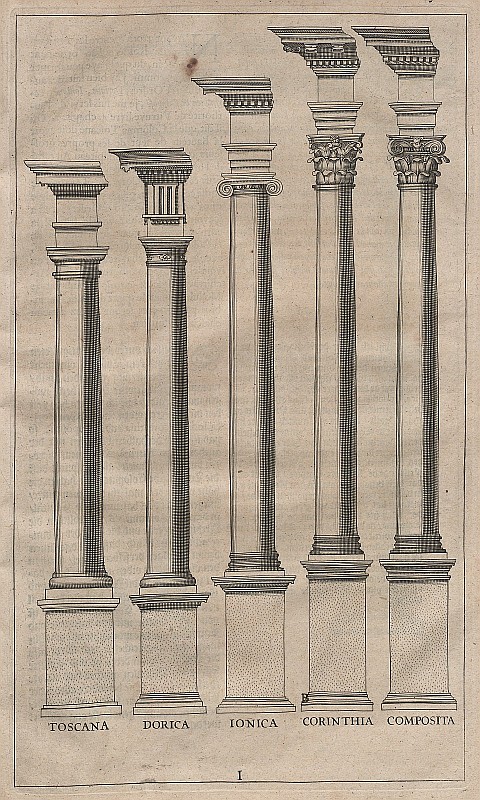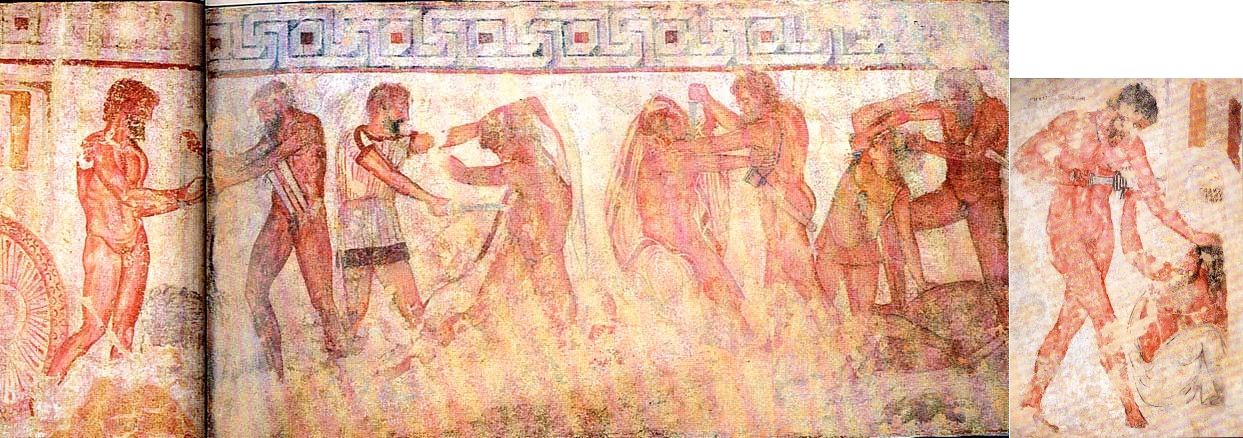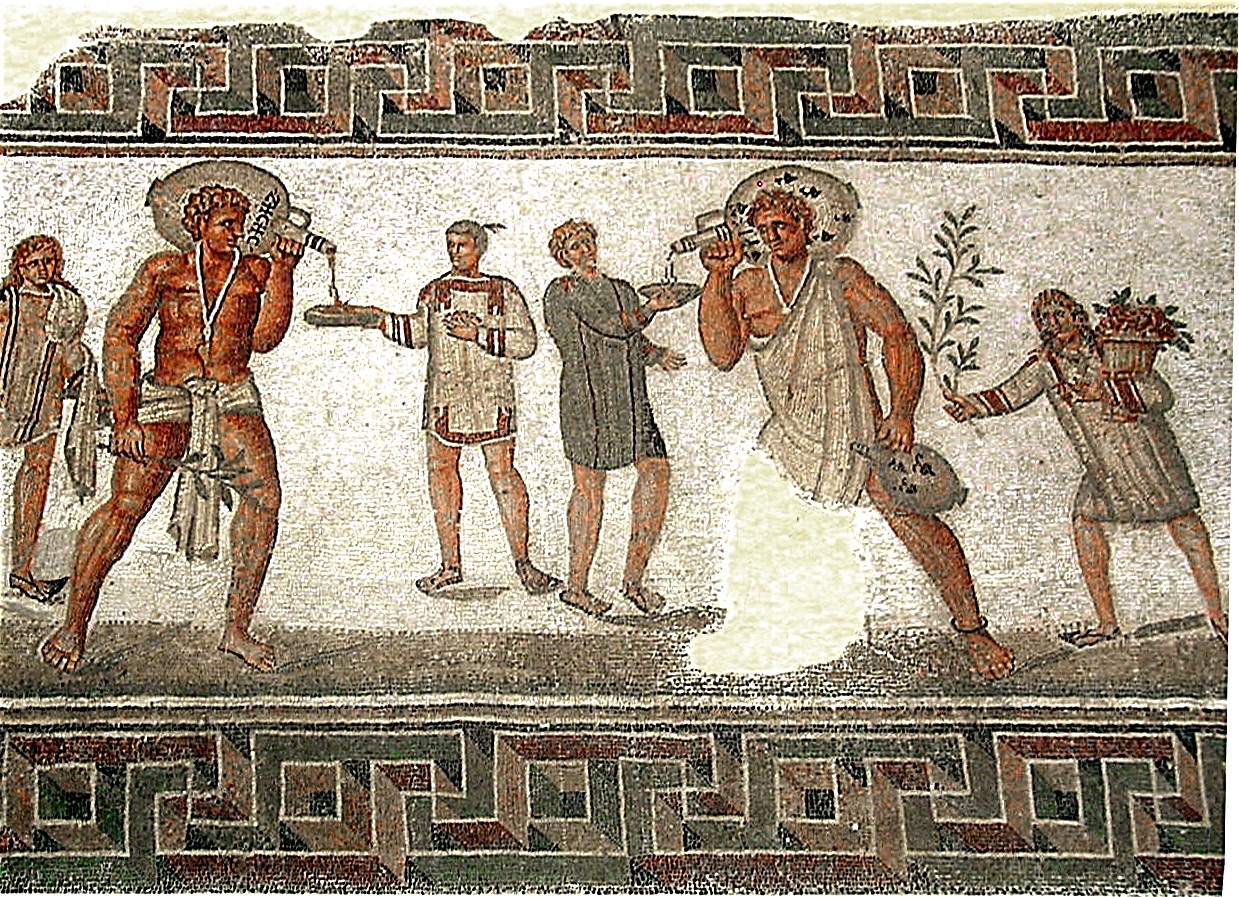|
Tomb Of Eurysaces The Baker
The tomb of Marcus Vergilius Eurysaces the baker is one of the largest and best-preserved freedman funerary monuments in Rome. Its sculpted frieze is a classic example of the "plebeian style" in Roman sculpture. Eurysaces built the tomb for himself and perhaps also his wife Atistia around the end of the Republic (ca. 50–20 BC). Located in a prominent position just outside today's Porta Maggiore, the tomb was transformed by its incorporation into the Aurelian Wall; a tower subsequently erected by Honorius covered the tomb, the remains of which were exposed upon its removal by Gregory XVI in 1838. What is particularly significant about this extravagant tomb is that it was built by a freedman, a former slave. Three sides of the slightly trapezoidal structure remain largely intact. All have the same form, with a plain lower storey now mostly below ground level but exposed, consisting of pairs of engaged columns between flat slabs, all crammed together with no space in bet ... [...More Info...] [...Related Items...] OR: [Wikipedia] [Google] [Baidu] |
Porta Maggiore
The Porta Maggiore ("Larger Gate"), or Porta Prenestina, is one of the eastern gates in the ancient but well-preserved 3rd-century Aurelian Walls of Rome. Through the gate ran two ancient roads: the Via Praenestina and the Via Labicana. The Via Prenestina was the eastern road to the ancient town of Praeneste (modern Palestrina). The Via Labicana (now called the '' Via Casilina'') heads southeast from the city. The gate The Porta Maggiore is by far the best urban site to visit for an understanding and view of the ancient aqueducts. It is a monumental double archway built of white travertine. It was first known as the Porta Prenestina, perhaps a reference to the road over which it passes (the Via Praenestina). The "gate," built in 52 AD by the emperor Claudius, was originally intended to provide a decorative section of support for two aqueducts, the Aqua Claudia and the Anio Novus. At that time these aqueducts crossed the ancient Via Labicana and Praenestina roads thereby p ... [...More Info...] [...Related Items...] OR: [Wikipedia] [Google] [Baidu] |
Composite Order
The Composite order is a mixed order, combining the volutes of the Ionic order capital with the acanthus leaves of the Corinthian order.Henig, Martin (ed.), ''A Handbook of Roman Art'', p. 50, Phaidon, 1983, In many versions the composite order volutes are larger, however, and there is generally some ornament placed centrally between the volutes. The column of the composite order is typically ten diameters high, though as with all the orders these details may be adjusted by the architect for particular buildings. The Composite order is essentially treated as Corinthian except for the capital, with no consistent differences to that above or below the capital. The Composite order is not found in ancient Greek architecture and until the Renaissance was not ranked as a separate order. Instead it was considered as an imperial Roman form of the Corinthian order. Though the Arch of Titus, in the forum in Rome and built in 82 AD, is sometimes cited as the first prominent survivi ... [...More Info...] [...Related Items...] OR: [Wikipedia] [Google] [Baidu] |
College Art Association
The College Art Association of America (CAA) is the principal organization in the United States for professionals in the visual arts, from students to art historians to emeritus faculty. Founded in 1911, it "promotes these arts and their understanding through advocacy, intellectual engagement, and a commitment to the diversity of practices and practitioners." CAA currently has individual members across the United States and internationally; and institutional members, such as libraries, academic departments, and museums located in the United States. The organization's programs, standards and guidelines, advocacy, intellectual engagement, and commitment to the diversity of practices and practitioners, align with its broad and diverse membership. CAA publications, programs and grants CAA publishes several academic journal An academic journal or scholarly journal is a periodical publication in which scholarship relating to a particular academic discipline is published. Academic ... [...More Info...] [...Related Items...] OR: [Wikipedia] [Google] [Baidu] |
The Art Bulletin
The College Art Association of America (CAA) is the principal organization in the United States for professionals in the visual arts, from students to art historians to emeritus faculty. Founded in 1911, it "promotes these arts and their understanding through advocacy, intellectual engagement, and a commitment to the diversity of practices and practitioners." CAA currently has individual members across the United States and internationally; and institutional members, such as libraries, academic departments, and museums located in the United States. The organization's programs, standards and guidelines, advocacy, intellectual engagement, and commitment to the diversity of practices and practitioners, align with its broad and diverse membership. CAA publications, programs and grants CAA publishes several academic journals, including ''The Art Bulletin'', one of the foremost journals for art historians in English, and '' Art Journal'', a quarterly journal devoted to twentieth- and t ... [...More Info...] [...Related Items...] OR: [Wikipedia] [Google] [Baidu] |
Trimalchio
Trimalchio is a character in the 1st-century AD Roman work of fiction '' Satyricon'' by Petronius. He features as the ostentatious, nouveau-riche host in the section titled the "Cēna Trīmalchiōnis" (The Banquet of Trimalchio, often translated as "Dinner with Trimalchio"). Trimalchio is an arrogant former slave who has become quite wealthy as a wine merchant. The name "Trimalchio" is formed from the Greek prefix τρις and the Semitic מלך ( melech) in its occidental form Malchio or Malchus. The fundamental meaning of the root is "King", and the name "Trimalchio" would thus mean "Thrice King" or "greatest King". Character description His full name is "Gaius Pompeius Trimalchio Maecenatianus"; the references to Pompey and Maecenas in his name serve to enhance his ostentatious character. His wife's name is Fortunata, a former slave and chorus girl. Trimalchio is known for throwing lavish dinner parties, where his numerous slaves bring course after course of exotic delicacies ... [...More Info...] [...Related Items...] OR: [Wikipedia] [Google] [Baidu] |
Parvenu
A ''parvenu'' is a person who is a relative newcomer to a high-ranking socioeconomic class. The word is borrowed from the French language; it is the past participle of the verb ''parvenir'' (to reach, to arrive, to manage to do something). Origin The word ''parvenu'' typically describes a person who recently ascended the social ladder, especially a ''nouveau riche'' or "new money" individual. The famous Margaret Brown, who survived the sinking of the ''Titanic'' in 1912, was portrayed as a "new money" individual, most notably in the "climbing social classes" musical '' The Unsinkable Molly Brown'', because of her impoverished Irish immigrant roots and lack of social pedigree. The ''Oxford English Dictionary'' defines a ''parvenu'' as: "A person from a humble background who has rapidly gained wealth or an influential social position; a nouveau riche; an upstart, a social climber. Also in extended use. Generally used with the implication that the person concerned is unsuited t ... [...More Info...] [...Related Items...] OR: [Wikipedia] [Google] [Baidu] |
Nouveau Riche
''Nouveau riche'' (; ) is a term used, usually in a derogatory way, to describe those whose wealth has been acquired within their own generation, rather than by familial inheritance. The equivalent English term is the "new rich" or "new money" (in contrast with "old money"; french: vieux riche ). Sociologically, ''nouveau riche'' refers to the person who previously had belonged to a lower social class and economic stratum (rank) within that class; and that the new money, which constitutes their wealth, allowed upward social mobility and provided the means for conspicuous consumption, the buying of goods and services that signal membership in an upper class. As a pejorative term, ''nouveau riche'' affects distinctions of type, the given stratum within a social class; hence, among the rich people of a social class, ''nouveau riche'' describes the vulgarity and ostentation of the newly rich person who lacks the worldly experience and the system of values of "old money", of inherit ... [...More Info...] [...Related Items...] OR: [Wikipedia] [Google] [Baidu] |
Banausic
''Banausos'' (Ancient Greek , plural , ''banausoi'') is a pejorative applied to the class of manual laborers or artisans in Ancient Greece. The related abstract noun – ''banausia'' is defined by Hesychius as "every craft () onductedby means of fire", reflecting the folk etymology of the word as coming from (''baunos'') "furnace" and (''auō'') "to dry".''Banausie''. In: Heinrich August Pierer, Julius Löbe (in German): ''Universal-Lexikon der Gegenwart und Vergangenheit.'' Fourth ed., vol. 2; Altenburg 1857, page 264 (Online bei zeno.org) The actual etymology of the words is unknown; they are not attested outside Attic- Ionic or before the 5th century BC. The epic heroes call their smiths – '' dēmiourgoi''. Athenian usage The use of ''banausos'' follows an economic transition in Greece: the use of coinage, the invention of the trireme and of hoplite armor, the prevalence of chattel slavery permitted the rise of a new hoplite class, who used the term to dist ... [...More Info...] [...Related Items...] OR: [Wikipedia] [Google] [Baidu] |
Ingenui
''Ingenui'' or ''ingenuitas'' (singular ''ingenuus''), was a legal term of ancient Rome indicating those freemen who were born free, as distinct from freedmen who had once been slaves. In ancient Rome, free men were either ''ingenui'' or ''libertini''. ''Ingenui'' indicated those free men who were born free. ''Libertini'' were those men who were manumitted from legal slavery. Although freedmen were not ''ingenui'', the sons of ''libertini'' were ''ingenui''. A ''libertinus'' could not by adoption become ''ingenuus''. If a female slave (''ancilla'') was pregnant, and was manumitted before she gave birth to the child, that child was born free, and therefore was ''ingenuus''. In other cases, also, the law favored the claim of free birth, and consequently of ''ingenuitas''. Paulus, ''Sent. Recept.'' iii. 24, and v. 1. ''De liberali causa'' If a man's ingenuitas was a matter in dispute, there was a ''judicium ingenuitatis'', which was a court to determine status with regard to pa ... [...More Info...] [...Related Items...] OR: [Wikipedia] [Google] [Baidu] |
Filiation
Filiation is the legal term for the recognized legal status of the relationship between family members, or more specifically the legal relationship between parent and child. As described by the Government of Quebec: Filiation is the relationship which exists between a child and the child’s parents, whether the parents are of the same or the opposite sex. The relationship can be established by blood, by law in certain cases, or by a judgment of adoption. Once filiation has been established, it creates rights and obligations for both the child and the parents, regardless of the circumstances of the child’s birth. Filiation differs from, but impacts, both parental rights and inheritance. The statute of limitations period for filiation is thirty years. An example of law regarding filiation is found in the Civil Code of Quebec, Book 2, Title 2 "Filiation", which details how filiation may be established, claimed, and transferred. Filiation and adoption When an adoption takes ... [...More Info...] [...Related Items...] OR: [Wikipedia] [Google] [Baidu] |
Roman Naming Conventions
Over the course of some fourteen centuries, the Romans and other peoples of Italy employed a system of nomenclature that differed from that used by other cultures of Europe and the Mediterranean Sea, consisting of a combination of personal and family names. Although conventionally referred to as the ''tria nomina'', the combination of praenomen, nomen, and cognomen that have come to be regarded as the basic elements of the Roman name in fact represent a continuous process of development, from at least the seventh century BC to the end of the seventh century AD. The names that developed as part of this system became a defining characteristic of Roman civilization, and although the system itself vanished during the Early Middle Ages, the names themselves exerted a profound influence on the development of European naming practices, and many continue to survive in modern languages. Overview The distinguishing feature of Roman nomenclature was the use of both personal names and reg ... [...More Info...] [...Related Items...] OR: [Wikipedia] [Google] [Baidu] |
Libertus
Slavery in ancient Rome played an important role in society and the economy. Besides manual labour, slaves performed many domestic services and might be employed at highly skilled jobs and professions. Accountants and physicians were often slaves. Slaves of Greek origin in particular might be highly educated. Unskilled slaves, or those sentenced to slavery as punishment, worked on farms, in mines, and at mills. Slaves were considered property under Roman law and had no legal personhood. Most slaves would never be freed. Unlike Roman citizens, they could be subjected to corporal punishment, Sexuality in ancient Rome#Master-slave relations, sexual exploitation (Prostitution in ancient Rome, prostitutes were often slaves), torture and summary execution. Over time, however, slaves gained increased legal protection, including the right to file complaints against their masters. One major source of slaves had been Roman military expansion during the Roman Republic, Republic. The use of ... [...More Info...] [...Related Items...] OR: [Wikipedia] [Google] [Baidu] |
.jpg)


